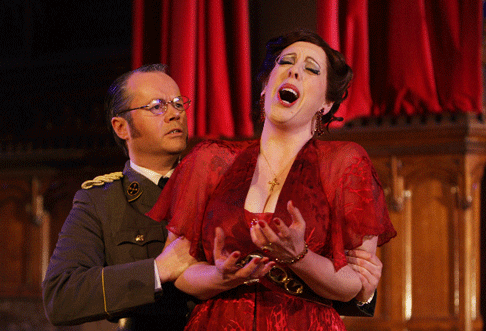It’s what happened to Northern Ireland Opera, however, on day two of its
Tosca staging, when a device planted by dissident terrorists (the
second in five days) forced the rapid abandonment of St Columb’s
Cathedral in Londonderry, the Act One venue in this site-specific staging. The
show did indeed go on: Act One as a concert performance, Acts Two and Three in
the city’s Guildhall and St Columb’s Hall, as scheduled. “We
were prepared and decided we were going to go ahead with it anyway”,
commented conductor Nicholas Chalmers stoically. “We will not be
beaten”.
Artistically the production was a triumph. Its keynote was the studious
avoidance of all the blowsiness and bombast which can reduce Tosca to
the “shabby little shocker” of operatic legend. Oliver
Mears’s staging had shock without shabbiness: in calm, clinical fashion
he cut to the political quick of the drama, the raw ingredients of political
struggle, state oppression, torture, murder, suicide and religion starkly
anatomised in a city where for the thirty years of “The Troubles”
(Northern Ireland’s vicious sectarian conflict) they were the lingua
franca of everyday existence. A Tosca with contemporary relevance?
Just a little…
 Oliver Mears
Oliver Mears
Act Two’s extended confrontation between Tosca and police chief
Scarpia was in this respect seminal. Belfast-born Giselle Allen, in her first
Tosca, delivered an already sharply modulated and nuanced reading of the part,
unleashing fulsome waves of tone in the most straitened outbursts, retaining
poise and focus in quieter, self-confessional passages. No surprise to learn
that she is already an acclaimed Jenůfa. The Scarpia, Paul Carey Jones,
was a study in restrained menace, cold, icy, vocally unhistrionic — and
pretty scarifying. Mears utilised the given space (the sober wood-panelling and
civic symbols of Derry City Council’s building) superbly: the attempted
rape happened within touching distance of the front-row spectators, blood
spurted graphically in front of their noses from the stabbing, and audience
members filed past the still visible body of the butchered Scarpia, prostrate
on a committee table at floor level, to get their interval refreshment.
“Strong stuff”, a man next to me commented, adding a pointed
reference to a notorious police interrogation centre in Northern Ireland. I
said nothing.
 Giselle Allen as Tosca and Paul Carey Jones as Scarpia
Giselle Allen as Tosca and Paul Carey Jones as Scarpia
Earlier Mears had used a completely different logistical lay-out for Act One
in St Columb’s Cathedral, the orchestra deployed in a side chapel and
behind the altar, the aisle a conduit for the arrival of the dramatis personae
and the excellent choir of local schoolchildren who intoned the “Te
Deum” lustily, encouraged by the vividly comic and firmly voiced
Sacristan of Cork baritone Brendan Collins. Mexican tenor Jes˙s LeÛn, slightly
stiffer and less stage-confident than his Tosca, had handsome features
and a pleasingly sappy upper voice going for him. His Cavaradossi was brooding,
perhaps a touch too interiorised for effective projection. He rose to Act
Three’s “E lucevan le stelle” (in English), sung in a
cramped, grubbily-tiled police execution chamber where Mears had earlier staged
a shockingly literal dumb-show shooting over Puccini’s lengthy orchestral
introduction. I wondered what my interval interlocutor might be thinking.
The production as a whole was the very opposite of opera as commodification:
there was no desire evident to cushion the rawness of the narrative content, no
truck with the idea of opera as plush, comfortable middle-class entertainment.
This was Tosca as riveting political drama, visceral without being in
any way artificially pumped-up or gimmicky. It made the work seem like a truly
great opera, rather than one which is merely massively popular. The audience
stood as one at the end, noisily acclaiming what was undoubtedly a momentous
evening for Northern Ireland Opera, in a part of the United Kingdom which has
been on short (often non-existent) rations operatically throughout its
ninety-year history. The new company’s first full (2011-12) season is
awaited with the keenest interest.
Terry Blain
image=http://www.operatoday.com/Tosca_pic-2.gif
image_description=Giselle Allen as Tosca and Jesus Leon as Cavaradossi [Photo courtesy of NI Opera]
product=yes
product_title=Giacomo Puccini: Tosca
product_by=Floria Tosca: Giselle Allen (31st March/2nd April) Lee Bisset (1st April matinee performance); Mario Cavaradossi: Jesus Leon; Scarpia: Paul Carey Jones; Sacristan: Brendan Collins; Angelotti: John Molloy; Spoletta: Andrew Rees. Director: Oliver Mears. Conductor: Nicholas Chalmers. Designer: Simon Holdsworth. Lighting Designer: Kevin Treacy.
product_id=Above: Giselle Allen as Tosca and Jesus Leon as Cavaradossi
Photos courtesy of NI Opera